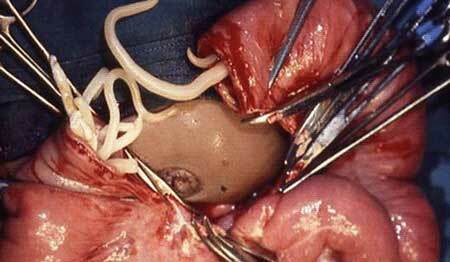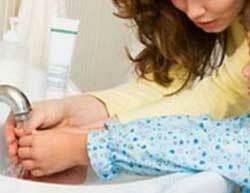A helminth is a whole group of parasitic worms that settle and multiply in the human body."Helminthos" in Greek means "worm".Symptoms, causes, methods of treatment and prevention of helminthiosis are described in detail in this publication.
Contents
- 1 Helminthiosis - What is it?
- 2 Worm infections
- 3 Signs and symptoms of helminthiosis
- 4 Signs of helminthiosis in adults
- 5 Features of helminthiosis in children
- 6 Diagnosis of helminthic infection
- 7 Treatment of helminthiasis in children and adults
- 8 Helminthiasis prevention measures
Helminthiases - What is it?
In simple language, helminthiases are a generalized name for human diseases caused by helminths. The names of helminthiases depend on the type of parasite, for example, trichinella cause the development of trichinellosis, ascarids - ascariasis, pinworms provoke enterobiasis.

Among helminths there are round, flat, tapeworms, and often found other than the above are:
- echinococcus;
- pork and bovine tapeworms, or chain;
- nekatory;
- is sloppy;
- hookworms;
- multicep;
- cysticerc;
- wide ribbon;
- alveococcus;
- dwarf tseleen.
The life cycle of all helminth worms consists of three stages - eggs, larvae and a mature, or vegetative, individual. The first two are more often developed in the body of intermediate hosts, for example, fish, cats, livestock, or in soil and water, and when ingested, a third stage appears, and the worm functions and multiplies. A person can act for a parasite both as a final and an intermediate host.
Helminths can settle not only in the intestines, but also in other organs, affecting the liver, kidneys, vessels, pancreas, lungs, brain. Depending on where the parasite is located, various symptoms of helminthiasis appear.
Parasitic pathology can occur in a latent or severe acute form, with serious complications and a threat to life. In the organism of one person several species of helminths can settle.
Ways of infection with helminthiosis

The immediate cause of helminthiasis is the ingestion of a parasitic worm into the body of a larva or eggs. This is facilitated by factors that create conditions for the penetration of the parasite into the human body:
- Non-compliance with personal hygiene - neglect of washing hands before eating and cooking, eating dirty or poorly washed fruits, vegetables and berries, unsanitary conditions in a living or working environment, contact with petswithout observance of precautions( washing hands, etc.), drinking water from water bodies.
- Insufficient processing of food during cooking - consumption of raw milk or raw water, poorly processed fish or meat thermally.
- Pathologies of the gastrointestinal tract, dysbiosis.
- Weakened immunity, for example, in pregnancy, in the elderly and in children.
From person to person are transferred enterobiosis, ascaridosis, trichocephalosis, thenia dosis, ankylostomiasis. The source of opisthorchiasis, schistosomiasis, dracunculiasis, fascioliasis can also be animals.
Trichinella, alveococcus and echinococcus are transmitted only from animals.
Signs and symptoms of helminthiosis
Clinical manifestations of helminthiases are diverse, depending on the specific pathogen and its localization in the body. They can arise from different systems and are often regarded as signs of other diseases of internal organs. Symptoms of helminthiosis in adults and children are different in the acute and chronic stages of pathology.
The acute form of helminthiosis lasts from 2 to 8 weeks after penetration of the invasion into the body, after which it changes into a chronic one, which can last from 3-6 months to several years.
The acute stage is characterized by an increase in immunity activity in response to ingress of foreign objects, and the symptoms for most helminthiases at this time are similar:
- high temperature and sweating;
- swelling;
- appearance of rash;
- enlarged lymph nodes;
- soreness of the joints and muscles;
- bloating;
- diarrhea or constipation;
- the spleen and liver are enlarged;
- blood test shows an increase in the level of eosinophils( type of white blood cells).
 The symptomatology of chronic helminthiasis becomes more specific and is caused by the localization of the parasite. For example, when helminths are found in the intestine, there are pains in the abdomen, stool disorders, flatulence.
The symptomatology of chronic helminthiasis becomes more specific and is caused by the localization of the parasite. For example, when helminths are found in the intestine, there are pains in the abdomen, stool disorders, flatulence.
The course of the disease is often accompanied by apathy, a depressed mood. It happens that the signs are absent or weakly expressed, and notable manifestations occur only if the worm is large enough( wide ribbon, pig or bovine tapeworm).
Specific symptoms of helminthiases:
- development of iron deficiency anemia - with ankylostomiasis;
- prolapse of the rectum, hemorrhagic colitis - with trichocephalus;
- edema due to stagnation of lymph, allergy, inflammation of lymphatic vessels - with filariasis;
- pancreatitis, hepatitis, cholangitis, neurologic disorders - with fascioliasis, opisthorchiasis;
- bleeding after urination - with genitourinary schistosomiasis;
- pancreatitis, intestinal obstruction, jaundice - with ascariasis.
Asymptomatic flow is characteristic of cysticercosis, echinococcosis and alveococcosis, even in the case of a significant lesion of internal organs. Only with cysticercosis can there be symptomatology of neurological nature( apathy, cramps, sudden change of mood and others).
The danger of a hidden course of the disease is that large parasitic cysts without timely removal of them, are capable of provoking organ rupture.
This leads to internal bleeding and the ingress of a significant number of helminths into the bloodstream and, as a result, to peritonitis, anaphylactic shock, pleurisy and other complications.
Characteristics of helminthiosis in adults

Characteristic signs of helminthiasis in adults are manifested in the form of several syndromes:
- Toxico-allergic, arising in the acute phase, joint aches and pain in the muscles, fever, swelling and rash, less often pneumonia, myocarditis, hepatitis, encephalopathy.
- Local lesions are symptoms from a particular organ in which the parasites have settled.
- Disrupted nutrition, in which helminths absorb most of the nutrients that are ingested with food. As a result, weight loss, anemia, vitamin deficiencies, protein deficiency are observed.
- Immunosuppression - a sharp decrease in resistance to infections.
Read more about the symptoms of worms in humans.
Features of helminthiasis in children
In childhood, the risk of helminth infection is higher because:
- the child contacts many peers during games, training;
- immunity of children is not formed until the end;
- does not develop personal hygiene skills.
Symptoms of helminthiosis in children are intoxication of the body, allergic manifestations and susceptibility to infections. Enterobiasis in childhood is more common, while the child can complain of itching in the anus.
Intestinal obstruction develops with ascaris infection, and this is the second most common parasitic worm that affects children. Less commonly diagnosed trichocephalus and hookworm disease, which are characterized by signs of fever, coughing, and stool disorders.
Otherwise, the symptomatology of helminthiases in children is similar to that in adults.
Diagnosis of infection with helminths
Morphological laboratory diagnostics of helminthiases involves the study of pieces of tissue taken by biopsy or puncture of an organ. Used rarely - in cases where parasites are present in the thickness of tissues - with shade, cysticercosis, trichinosis.
Serological, general clinical and immunological methods are also used, including ultrasound of organs, urine and blood tests, X-rays, computed tomography, ELISA and others.
Parasitological methods are always used, they allow us to identify a variety of helminths that caused pathology. They are the most informative, with their help eggs, larvae and vegetative individuals of worms are found in intestinal mucus, feces, bile, blood, urine, gastric juice, vomit, sputum.
These biological fluids are examined under a microscope, and upon detection of parasites or fragments thereof, the diagnosis is confirmed. Additional diagnostics are rarely performed - only if the worm's appearance could not be established.
The most common source for analysis is feces, which are studied by different methods:
- Kato - used in most cases to detect helminth eggs;
- precipitation of Richie - for the detection of schistosomes;
- Harada-Mori - to find the cloak and hookworm;
- Berman - Detects the larvae of strongyloid.
Analysis of samples of the contents of the duodenum and bile helps to identify parasites located in the pancreas, liver, bile ducts and upper intestine. Blood is given up if there is suspicion of helminthiasis, and worms or their eggs in feces or biological fluids have not been detected.
Treatment of helminthiosis in children and adults
Treatment of helminthiosis is aimed at the destruction of worms that have settled in the body, therefore its main component is antiparasitic agents that cause the death of helminths in all phases of their life cycle.
Common types of helminthiases and drugs used for treatment are indicated in the table.
| diagnosis / drug | Pyrantel | Albendazole | Praziquantel |
| Enterobiasis | + | + | |
| Ascariasis | + | ||
| teniasis | + | + | |
| clonorchiasis | + | + | |
| Echinococcosis | + | ||
| Trichinosis | + | ||
| Hookworm | + | + | |
| Opisthorchiasis | + | ||
| Schistosomiasis | + | ||
| Multiple nematodes | |||
| Strongyloidosis | + |
| Diagnosis / Preparation | Mebendazole | Levamisole | Piperazine |
| Enterobiasis | + | + | + |
| Askaridoz | + | + | + |
| teniasis | + | ||
| clonorchiasis | |||
| Echinococcosis | + | ||
| Trichinosis | + | ||
| Hookworm | + | + | |
| Opisthorchiasis | |||
| schistosomiasis | |||
| Multiple nematodes | + | ||
| Strongyloidiasis | + | + |
In addition to antihelminthic drugs for the treatment of helminthiasis, sorbents for the purification of the intestine( Polysorb, Activated charcoal, Polypefan) and antihistamines for the relief of an allergic reaction( Claritin, Zirtek, Suprastin) are necessarily prescribed.
The reception of the latter begins 5 days before the application of antiparasitic drugs and is carried out for another 5 days after its completion.
After passing the course of treatment with preparations against helminths, it is necessary to add probiotics to sorbents and antihistamines for normalization of intestinal microflora.
In addition to helminthic therapy may be prescribed:
- means for normalizing blood pressure, if hypertension develops against the background of the disease;
- glucocorticosteroids are indicated in severe forms of helminthiasis when there is vasculitis, arachnoiditis, myocarditis and other complications;
- with severe intoxication intravenously injected Hemodez, glucose solution, orally - ascorbic acid, calcium chloride, vitamin B6.
The diet should consist of easily digestible food - vegetables, sour-milk products, fruits, lean soups and cereals. Before the course of treatment for helminthiasis, the house is thoroughly cleaned with soapy water and bed linen is completely changed. The daily laundry should be ironed with a hot iron.
Prevention of helminthiosis
 Prevention of helminthiosis in children and adults is to remove conditions that contribute to infection. This is a careful heat treatment of products of animal origin, the use of only purified or boiled water, washing vegetables, greens and fruits, and personal hygiene.
Prevention of helminthiosis in children and adults is to remove conditions that contribute to infection. This is a careful heat treatment of products of animal origin, the use of only purified or boiled water, washing vegetables, greens and fruits, and personal hygiene.
Twice a year preventive courses of taking antihelminthic drugs will not interfere, especially if there are animals at home or there are other risk factors for helminth infection.



